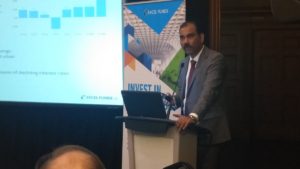
(Sponsor Content)
The Indian economy is firing on all cylinders, fueled by policy reforms that are the catalysts for growth in one of the world’s fastest growing economies.
This was the central theme of the message delivered by Atul Penkar, lead sub-advisor of the Excel India Fund at an investor conference held in Toronto on September 19th. Mr Penkar is also the Head of Offshore Equities at Birla Sun Life Asset Management Company Ltd. (BSLAMC) in India.
Titled “Expert Insights into India: The World’s Growth Giant,” the conference was sponsored by Excel Funds Management Inc., in association with BSLAMC, the on-the ground sub-adviser of Excel’s three India-focused funds: Excel India Fund, Excel India Balanced Fund and Excel New Leaders Fund.
Mr. Penkar noted that India’s GDP growth has exceeded long-term projections made by Goldman Sachs and that the country was already close to achieving 2020 growth forecasts five years earlier.[1]
Huge Demographic Dividend

One of the largest contributors to India’s growth is its huge demographic dividend, comprising a young workforce that is expected to reach 1.1 billion by 2050. In addition, India’s growing middle class and its 400 million strong millennial population are upwardly mobile and better educated, providing impetus for growth going forward.
As a result of the government’s investor friendly policies, foreign direct investments have reached more than US$40 billion during last year, up from just over US$11 billion 10-years prior.[2] It was noted that the CPP Investment Board, Caisse de dépôt et placement du Québec and Ontario Teachers Pension Plan are leading the Canadian institutional charge on investing in India and have so far collectively so invested US$6.3 billion.[3]
Although Indian equities are reasonably priced, albeit at above their 10-year average, earnings per share growth is expected to accelerate from 11.2% in 2017 to 20.8% in 2019, indicating scope for prices to climb much higher. [4]
Among the near-term growth drivers for companies are: positive real rates that are driving financial savings, greater consumption in both rural and urban communities, increased government spending, a recovery in commodity prices and lower interest costs resulting from declining interest rates.
Key themes driving growth
Some of the key themes identified by the manager that drive investment decisions in Excel’s funds include financial inclusion among the population at large, fiscal discipline, inflation management, Goods and Services Tax reform, curtailing the underground economy through demonetization, making it easier to do business, and infrastructure spending. [5]
An active manager that operates on-the-ground, BSLAMC has deep knowledge of the companies in which it invests and lives and breathes local economic and political conditions: providing the Excel funds that it manages with a competitive edge over passively managed Indian funds.
[1] Goldman Sachs: Dreaming with BRICs: The Path to 2050; IMF, WEO Database, July 2017
[2] Bloomberg data, from December 31, 2005 to December 31, 2016
[3] ibid
[4] Bloomberg data, as of August 22, 2017; Fiscal Year ending March 31
[5] Birla Sun Life Asset Management
Commissions, trailing commissions, management fees and expenses all may be associated with mutual fund investments. Please read the prospectus or Fund Facts document before investing. The indicated rates of return are the historical annual compounded total returns including changes in share or unit value and reinvestment of all dividends or distributions and do not take into account sales, redemption, distribution or optional charges or income taxes payable by any securityholder that would have reduced returns. Mutual funds are not guaranteed, their values change frequently and past performance may not be repeated. Rate of return is used only to illustrate the effects of compound growth and is not intended to reflect future values of the Fund or returns on investment in the Fund. Some of the information has been provided by external sources and is subject to change at any time. Excel Funds is not responsible for the accuracy, reliability or timeliness of the information supplied by external sources. Users wishing to rely upon this information should consult directly with the source of the information. Content provided by external sources is not subject to official languages, privacy and accessibility requirements.

